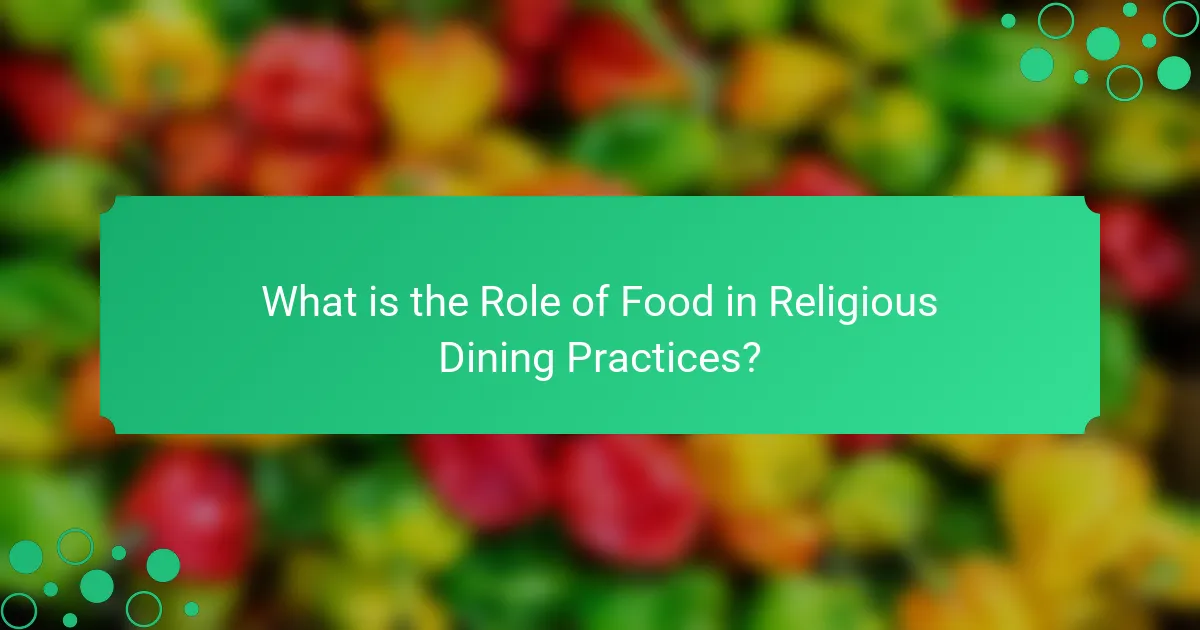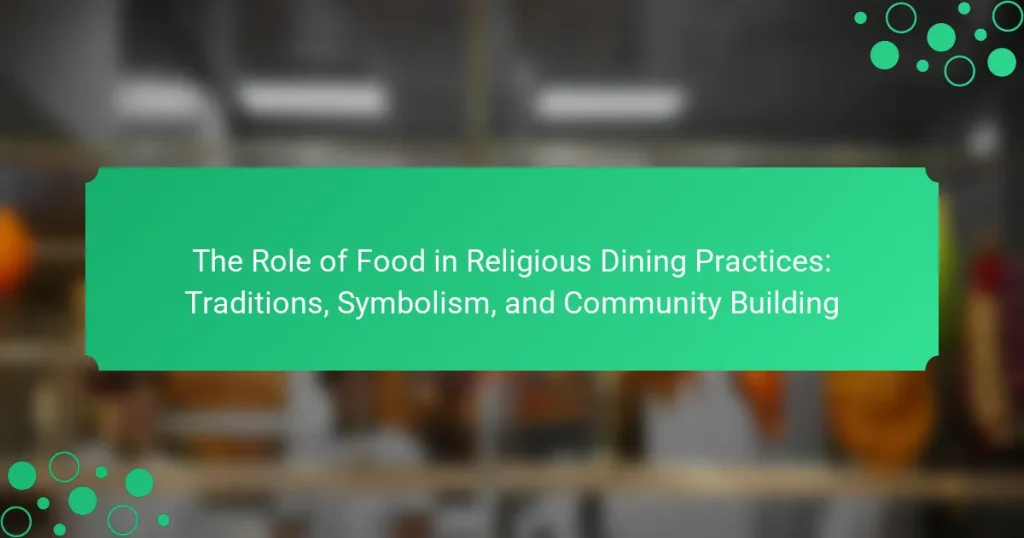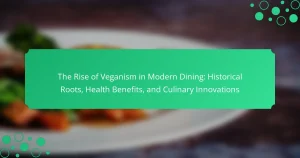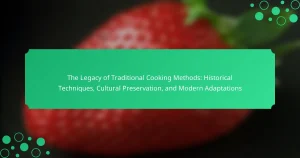Food serves as a crucial element in religious dining practices, acting as a medium for spiritual expression and communal bonding. Various religions incorporate specific foods into their rituals and ceremonies, such as bread and wine in Christian Eucharist celebrations and unleavened bread during Jewish Passover. Food often symbolizes key concepts like purity, sacrifice, and divine blessing across different faiths. Additionally, communal meals play a vital role in strengthening social ties within religious communities, fostering a sense of belonging and shared identity. This article explores the traditions, symbolism, and community-building aspects of food in religious contexts.

What is the Role of Food in Religious Dining Practices?
Food plays a significant role in religious dining practices. It serves as a medium for spiritual expression and communal bonding. Many religions incorporate specific foods into rituals and ceremonies. For example, bread and wine are central to Christian Eucharist celebrations. In Judaism, unleavened bread is consumed during Passover to commemorate the Exodus. Food often symbolizes purity, sacrifice, or divine blessing in various faiths. Additionally, communal meals strengthen social ties within religious communities. They foster a sense of belonging and shared identity among participants. Thus, food in religious contexts is not just sustenance; it embodies beliefs, traditions, and community values.
How do various religions incorporate food into their dining practices?
Various religions incorporate food into their dining practices through rituals, dietary laws, and communal meals. For example, in Judaism, kosher laws dictate what foods can be consumed and how they should be prepared. This practice emphasizes the spiritual significance of food. In [censured], sharing bread and wine during Communion symbolizes the body and blood of [censured]. This act fosters a sense of community among believers.
In [censured], halal dietary guidelines govern permissible foods. These rules reflect spiritual obedience and purity. Hinduism often involves vegetarianism as a principle of non-violence and respect for all living beings. This dietary choice is integral to many Hindu rituals.
Buddhism encourages mindful eating, often promoting vegetarianism to align with the principle of compassion. Fasting is also common in many religions, such as during Ramadan in [censured] or Lent in [censured], serving as a time for reflection and spiritual growth. These practices highlight the deep connection between food, [censured], and community in various religious traditions.
What specific foods are significant in different religious traditions?
Many specific foods hold significance in different religious traditions. In Judaism, unleavened bread, or matzah, is eaten during Passover to commemorate the Exodus from Egypt. In [censured], bread and wine are central to the Eucharist, symbolizing the body and blood of [censured]. In [censured], dates are commonly consumed to break the fast during Ramadan, reflecting the practice of the Prophet Muhammad. Hinduism often features rice and lentils in rituals, as they are considered pure and nourishing. In Buddhism, vegetarianism is encouraged, with rice and vegetables being staples, symbolizing non-violence and compassion. These foods are deeply intertwined with the respective beliefs and practices of each religion, reinforcing community and tradition.
How do dietary restrictions shape religious dining practices?
Dietary restrictions significantly shape religious dining practices by dictating what foods can be consumed. Different religions have unique guidelines regarding permissible and forbidden foods. For instance, Judaism prohibits pork and shellfish, while [censured] forbids alcohol and certain meats. These restrictions influence meal preparation and communal eating events. Religious dietary laws often promote a sense of identity and community among followers. Shared meals adhering to these guidelines strengthen social bonds within the faith. Historical texts, such as the Torah and the Quran, provide the foundation for these dietary laws. Consequently, dietary restrictions play a crucial role in defining religious observance and community cohesion.
Why is food symbolism important in religious contexts?
Food symbolism is important in religious contexts because it conveys deeper spiritual meanings and beliefs. It often represents sacred concepts, such as life, death, and renewal. For instance, bread and wine in [censured] symbolize the body and blood of [censured]. In Judaism, unleavened bread during Passover signifies the haste of the Exodus. Food also serves as a medium for communal bonding among adherents. Shared meals reinforce community ties and collective identity. Rituals involving food can enhance the spiritual experience and foster a sense of belonging. These practices are grounded in historical traditions and teachings, further solidifying their significance in religious life.
What are common symbols associated with food in religious rituals?
Common symbols associated with food in religious rituals include bread, wine, fruits, and grains. Bread often represents sustenance and life, as seen in [censured] with the Eucharist. Wine symbolizes joy and celebration, frequently used in various ceremonies. Fruits can signify abundance and fertility, especially in harvest festivals. Grains are often linked to growth and nourishment, representing the earth’s bounty. These symbols are rooted in historical practices and beliefs, reflecting the importance of food in spiritual contexts. For example, the Jewish Passover uses unleavened bread to commemorate the Exodus. Each symbol carries deep meaning, connecting the physical act of eating with spiritual significance.
How does food symbolism enhance spiritual experiences?
Food symbolism enhances spiritual experiences by creating deeper connections to beliefs and traditions. Symbolic foods often represent sacred concepts or narratives. For example, bread in [censured] symbolizes the body of [censured] during communion. This act of sharing food fosters unity among participants. Additionally, food rituals can evoke mindfulness and reflection. Eating symbolic foods during religious ceremonies encourages participants to contemplate their faith. Research indicates that food rituals can strengthen community bonds and individual [censured]. The act of consuming symbolic foods can transform ordinary meals into profound spiritual experiences.
How does community building occur through religious dining practices?
Community building occurs through religious dining practices by fostering shared experiences and connections among participants. These practices often involve communal meals that reinforce social bonds. Shared rituals during dining, such as prayers or blessings, create a sense of belonging. Food serves as a medium for expressing faith and cultural identity. For example, potluck dinners in many religious communities encourage participation and inclusivity. The act of sharing food symbolizes unity and cooperation. Research shows that communal dining strengthens interpersonal relationships and enhances group cohesion. Overall, religious dining practices play a vital role in cultivating community ties.
What role does shared food play in fostering community bonds?
Shared food plays a significant role in fostering community bonds. It creates a sense of belonging among individuals. Sharing meals encourages communication and interaction. This practice enhances social ties and strengthens relationships. Research shows that communal dining experiences increase feelings of trust and cooperation. For example, a study by the University of Oxford found that shared meals can improve group cohesion. Additionally, cultural traditions often revolve around communal food practices, reinforcing community identity. Overall, shared food acts as a catalyst for connection and unity within communities.
How do communal meals reflect religious values and teachings?
Communal meals reflect religious values and teachings by serving as a manifestation of shared beliefs and practices. These meals often symbolize unity and fellowship within a faith community. For example, in [censured], the Eucharist represents the body and blood of [censured], emphasizing the importance of communion among believers. In Judaism, the Passover Seder highlights themes of liberation and remembrance, reinforcing the collective identity of the Jewish people.
Furthermore, communal meals often include specific rituals that convey spiritual significance. Prayers, blessings, and traditional foods are integral to these gatherings, reinforcing core teachings. For instance, in [censured], the act of breaking fast during Ramadan with family and friends reflects gratitude and togetherness, aligning with Islamic values of charity and community support.
Additionally, these meals can serve as opportunities for teaching and passing down religious traditions. They create a space for storytelling and sharing lessons from sacred texts, strengthening the community’s faith. Overall, communal meals are vital in embodying and transmitting religious values and teachings across generations.
What are the historical roots of food in religious dining practices?
The historical roots of food in religious dining practices are deeply intertwined with cultural beliefs and rituals. Many ancient civilizations used food as offerings to deities. For example, the Egyptians presented bread and beer to gods during ceremonies. In Judaism, the Passover meal commemorates the Exodus, highlighting the significance of food in religious observance. Early Christians used communal meals, known as agape feasts, to foster community and share faith. Similarly, Hinduism incorporates food in rituals, with offerings to deities symbolizing devotion. These practices emphasize the connection between food, [censured], and community cohesion throughout history.
How have historical events influenced food traditions in religions?
Historical events have significantly influenced food traditions in religions. For example, the Exodus in Judaism led to the creation of Passover rituals. These rituals commemorate the liberation from slavery and emphasize unleavened bread, symbolizing haste. Similarly, the early Christian community adopted bread and wine as symbols of the Last Supper. This practice reflects the historical context of Jesus’ life and teachings. In [censured], the dietary laws of halal stem from historical practices and the teachings of the Prophet Muhammad. These laws shape food consumption and preparation practices among Muslims. Additionally, colonialism and migration have introduced new ingredients and cooking methods into various religious cuisines. This blending of traditions often results in unique fusion dishes that reflect historical exchanges. Overall, historical events have shaped the significance and practices surrounding food in religious contexts.
What changes have occurred in religious dining practices over time?
Religious dining practices have evolved significantly over time. Historically, communal meals were central to worship, fostering community bonds. In ancient times, offerings and sacrifices were common, symbolizing devotion. As societies modernized, these practices adapted to cultural shifts. Dietary restrictions based on religious texts became more formalized. The introduction of technology influenced food preparation and accessibility. Globalization allowed for a fusion of culinary traditions within religious contexts. Today, many religious gatherings emphasize inclusivity and dietary preferences. These changes reflect broader societal transformations and the ongoing relevance of food in spiritual life.
How do modern interpretations of religious dining practices manifest?
Modern interpretations of religious dining practices manifest through the incorporation of contemporary values and diverse dietary preferences. Many religious communities adapt traditional meals to accommodate vegan, vegetarian, or gluten-free diets. This inclusivity reflects a broader trend towards health consciousness and ethical eating. Additionally, social media influences how these practices are shared and celebrated. Online platforms allow for the exchange of recipes and dining experiences, fostering community engagement. Interfaith gatherings often blend various culinary traditions, promoting unity and understanding. Furthermore, the use of local and sustainable ingredients has become a priority, aligning with modern environmental concerns. These adaptations illustrate the dynamic nature of religious dining, evolving to meet the needs of contemporary followers while maintaining core traditions.
What contemporary trends are emerging in religious dining?
Contemporary trends in religious dining include a focus on sustainability and ethical sourcing of ingredients. Many religious communities are increasingly prioritizing plant-based diets as a reflection of stewardship for the Earth. This shift aligns with teachings in various faiths regarding compassion for all living beings. Additionally, there is a growing interest in fusion cuisines that blend traditional religious foods with modern culinary practices. This trend promotes inclusivity and reflects the multicultural nature of contemporary society. Another emerging trend is the incorporation of technology in dining experiences, such as virtual gatherings for religious meals. These trends demonstrate a dynamic evolution of religious dining practices in response to societal changes.
How do interfaith dining practices promote understanding and respect?
Interfaith dining practices promote understanding and respect by fostering dialogue and cultural exchange. These gatherings allow individuals from different faiths to share meals and traditions. Sharing food creates a sense of community and belonging. Participants can discuss their beliefs and values in a relaxed setting. This interaction helps to break down stereotypes and misconceptions. Research shows that shared meals can enhance empathy and cooperation among diverse groups. For instance, a study by the Pew Research Center found that interfaith activities promote positive relationships between different religious communities. Overall, interfaith dining creates opportunities for learning and mutual respect.
What practical tips can enhance religious dining experiences?
To enhance religious dining experiences, focus on creating a respectful atmosphere. Ensure that the food served aligns with dietary laws and traditions of the faith. Incorporate elements of ritual, such as prayers or blessings before meals, to foster a sense of community. Use traditional recipes to connect diners with cultural heritage. Encourage participation from all attendees in meal preparation and serving, promoting inclusivity. Set a communal table arrangement to facilitate conversation and connection. Lastly, consider the significance of the food’s symbolism within the religious context, which can deepen the dining experience.
How can individuals incorporate traditional foods into modern religious gatherings?
Individuals can incorporate traditional foods into modern religious gatherings by serving dishes that reflect cultural heritage. This practice honors customs and strengthens community bonds. For example, during a Jewish Passover Seder, matzah and charoset are essential. In Hindu gatherings, offering prasad, a blessed food, is customary. These foods often hold symbolic meanings linked to faith and history. Research shows that traditional foods enhance the spiritual experience and foster inclusivity. Incorporating these dishes can create a sense of belonging among participants.
What are best practices for hosting a religious communal meal?
Best practices for hosting a religious communal meal include planning the menu thoughtfully. Consider dietary restrictions and preferences of attendees. Ensure that the meal reflects the cultural and religious significance of the event. Organize the seating arrangement to promote fellowship and inclusivity. Prepare the space to create a welcoming atmosphere. Involve community members in the preparation and serving of the meal. This fosters a sense of belonging and shared responsibility. Provide a moment for prayer or reflection before the meal begins. This aligns with many religious traditions and enhances the communal experience.
The main entity of the article is food in religious dining practices. The article explores the significant role food plays in various religious traditions, emphasizing its symbolism, dietary restrictions, and communal aspects. It discusses specific foods associated with different faiths and how these items convey deeper spiritual meanings. Additionally, the article examines how communal meals foster community building and reflect religious values, along with contemporary trends and best practices for hosting religious dining experiences. Overall, it highlights the intricate relationship between food, [censured], and community cohesion across diverse religious contexts.




